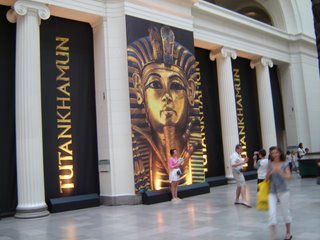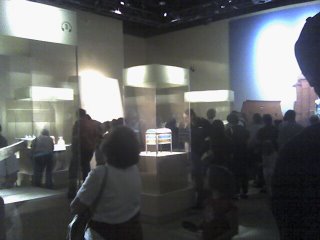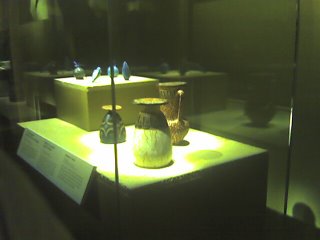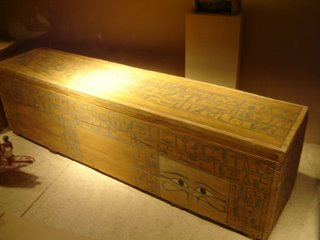King Tut at the Field Museum
 The main feature at Chicago's Field Museum was the King Tut exhibit, also known as "Tutankhamun and the Golden Age of the Pharaohs," which opened up while I was in the city.
The main feature at Chicago's Field Museum was the King Tut exhibit, also known as "Tutankhamun and the Golden Age of the Pharaohs," which opened up while I was in the city. The exhibit boasts more than 130 treasures from the tomb of King Tut and other ancient 18th century dynasties.
The exhibit boasts more than 130 treasures from the tomb of King Tut and other ancient 18th century dynasties. Visitors had to buy tickets in advance and the lines were long. It was with good reason, the last time these artifacts toured the world was 1977.
Visitors had to buy tickets in advance and the lines were long. It was with good reason, the last time these artifacts toured the world was 1977. Unfortunately, it made for a very annoyingly crowded affair, with way too many people looking at small artifacts. The layout of the exhibits seemed to encourage people to bump into each other, which proved to be a huge distraction while walking through it all.
Unfortunately, it made for a very annoyingly crowded affair, with way too many people looking at small artifacts. The layout of the exhibits seemed to encourage people to bump into each other, which proved to be a huge distraction while walking through it all. Here is a statue of Thuthmosis IV and his mother Tina, one of King Tut's ancestors. Tut was one of the last of a line, or 18th dynasty, that ran from 1539 to 1292 B.C. Some of these rulers included Ahmose, the founder of the dynasty, Tuthmosis I, and Amenhotep II, the king who created one of the first known peace treaties. Two of Tut's ancestors, Hatshepsut, one of the few female pharaohs, and Tuthmosis III, who tried to wipe her away, were the subject of an exhibit I saw a couple of months ago. You may find that here.
Here is a statue of Thuthmosis IV and his mother Tina, one of King Tut's ancestors. Tut was one of the last of a line, or 18th dynasty, that ran from 1539 to 1292 B.C. Some of these rulers included Ahmose, the founder of the dynasty, Tuthmosis I, and Amenhotep II, the king who created one of the first known peace treaties. Two of Tut's ancestors, Hatshepsut, one of the few female pharaohs, and Tuthmosis III, who tried to wipe her away, were the subject of an exhibit I saw a couple of months ago. You may find that here. Tutankhamun was the twelfth king of the 18th Dynasty, and ruled from approximately 1334-1325 B.C. He was about 16 years old when he died. The items on display are from the eras in and around his time period.
Tutankhamun was the twelfth king of the 18th Dynasty, and ruled from approximately 1334-1325 B.C. He was about 16 years old when he died. The items on display are from the eras in and around his time period. This, the Coffin of Tjuya, was the most impressive item on display. It has an interesting story, and I'm not talking about ancient times. Exelon CEO John Rowe had owned the 2,600-year-old Egyptian sarcophagus since 1998 and kept it on display in his office. How is that for a paperweight?
This, the Coffin of Tjuya, was the most impressive item on display. It has an interesting story, and I'm not talking about ancient times. Exelon CEO John Rowe had owned the 2,600-year-old Egyptian sarcophagus since 1998 and kept it on display in his office. How is that for a paperweight?Zahi Hawass, secretary-general of Egypt's Supreme Council of Antiquities demanded that it be returned to Egypt or given to the museum. Less than a week ago, in order to avoid further embarrassment and negative P.R., he obliged.
It made for a much better exhibit. No one is really sure who Tjuya is, but she died in style.
There were other artifacts on display, but the guards were pretty strict about not taking pictures of them. I'd write more about the exhibit if I could, but unfortunately all I can remember really is bumping into people. There were a couple of pieces that were interesting, but for the most part I walked away with a "that's it?" feeling.
Other than the coffin and another piece that held a dead person's liver or kidneys (I don't remember which) little of it really struck out as being very interesting. If anything, the Field Museum's permanent collection was just as good as the special exhibit. Here are some photos of what the museum has to offer at no extra charge:
 The museum's permanent collection has a wide variety of funerary coffins.
The museum's permanent collection has a wide variety of funerary coffins. You could get close to them and not have to worry about tons of people being around.
You could get close to them and not have to worry about tons of people being around. Here is a scroll from "The Book of the Dead," a guide to the Afterworld.
Here is a scroll from "The Book of the Dead," a guide to the Afterworld. Here are more burial coffins. This one is from 712 B.C.
Here are more burial coffins. This one is from 712 B.C.Part of the problem I had is that I'm from New York, and that the Metropolitan Museum of Art in the city has a much more impressive collection of Egyptian art than the Field Museum seemed to have.
Nevertheless, it was not time wasted. I just do not think I can recommend it compared to many of the other things I've seen in the museum or the city.



0 Comments:
Post a Comment
|<< Home